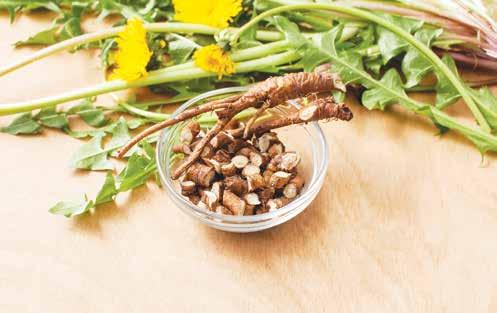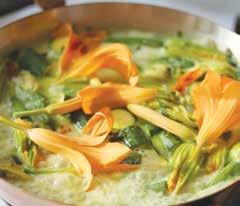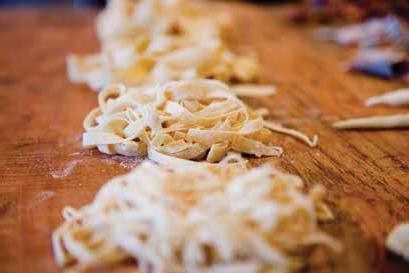
9 minute read
HEALING WATERS
HEALING WATERS Hot Baths Rejuvenate Body and Mind
by Marlaina Donato
Down to our very cells, water is the foundation of life. In the ancient Greco-Roman world, bathing in hot mineral springs and cool saltwater was a common ritual for better health, and spaces dedicated to baths were considered sacred. Stepping into a warm tub harkens back to the safety of the womb while offering abundant health benefits. Opting for a bath instead of a shower can not only help minimize headaches, insomnia, menstrual cramps, depression and chronic pain, but soothe a burnt-out nervous system. It can also enliven stagnant blood and lymphatic fluids, enabling metabolic waste to be carried out of the body through perspiration.
“Hydrotherapy is used in many natural health systems for a wide variety of ailments from inflammation to nervous system dysfunction and skin conditions. Whether you have access to a bathtub or not, there are many ways you can apply these traditional practices to your own self-care routine,” says Marlene Adelmann, herbalist and founder of the Herbal Academy, in Bedford, Massachusetts.
Whether we step into a full-body tub or a foot basin, water is a balm for the modern spirit bogged down by information overload and world events. “Taking time away in the sanctuary of warm water allows us to slip into a different state of mind and to release the energetic armor we defend ourselves with, as well as recuperate and heal internally,” says Kiva Rose Hardin, herbalist and co-editor of Plant Healer magazine, in New Mexico.
Insulin Sensitivity, Pain and Depression
A good bath can lower chronic systemic inflammation associated with osteoarthritis, rheumatoid arthritis and fibromyalgia. It can also impact how the body uses insulin. A 2018 study published in the Journal of Applied Physiology shows that immersion in hot water counters low-grade inflammation and increases glucose metabolism in individuals unable to exercise.
Hot baths relax muscles by promoting blood circulation through the tissues and prompting the nervous system into a calming parasympathetic mode. Cold-water soaks—preferably in the morning— provide perks that include boosting immunity and increasing depression-zapping endorphins such as dopamine.
A Handful of Nature
The skin is our largest organ, and what we put into the bath affects us from the outside-in. Bentonite clay for detoxing and Dead Sea salts for pain are great choices. Studies going back to the 1990s show significant, lasting effects of Dead Sea salts on those with osteoarthritis of the knee, as well as rheumatoid arthritis.
Fortifying the bath with Epsom salts, evaporated sea salt or Himalayan pink salt is highly beneficial. “Himalayan salt has 84 valuable trace minerals, including potassium, magnesium and sodium. It draws out toxins, cleanses the skin and helps cleanse the body energetically,” says Hellen Yuan, founder of the bath product company Hellen, in Brooklyn.
Adding bundles of fresh or dried herbs or snipping them into sachets can strengthen immune response and provide a welcome antidote to work-related stress. “Aromatic herbs and essential oils are inhaled through our olfactory system and make a beeline to our brains, signaling that it’s time to relax or feel energized,” says Adelmann, who emphasizes practical common sense. “Although flowers and leaves floating in the tub make for lovely social media posts, most household plumbing cannot handle big, bulky plant material. The simplest way to add herbs to a bath is by making a super-concentrated tea.” Hardin concurs, recommendingfresh or driedlavender, flowering goldenrod tops, holy basil leaves (tulsi, Ocimum tenuiflorum) or calendula blossoms.
Sacred Waters
Baths are good medicine for both genders. “Men carry so much stress in their bodies and typically hold in a lot of tension. A good bath brew eases the muscles and replenishes the mind and soul,” says Yuan.
Bathing can be the ultimate sacred offering to the body. From her wood-fired outdoor tub at the edge of a starlit mesa, Hardin advises, “Efforts need not be expensive or time-consuming. Just focused intent will inherently return a sufficient degree of sensuality, magic and beauty to the bath.”
Marlaina Donato is the author of Multidimensional Aromatherapy. Connect at AutumnEmbersMusic.com.
No-Waste Garden Edibles Ways to Maximize Your Garden’s Bounty

by April Thompson
Most gardens are loaded with delicious, nutritious food that goes uneaten and overlooked, from edible greens like sweet potato leaves to flavorful flowers like tulips, marigolds and wisteria. Getting better acquainted with the edible parts of common backyard plants opens up a world of culinary possibilities. With continued concerns around potential exposure to COVID-19, maximizing a garden’s bounty while minimizing trips to the grocery store is an added benefit.
“Food foraged from your backyard is fresher, tastier and cheaper than store-bought food,” says Ellen Zachos, the Santa Fe author of Backyard Foraging: 65 Familiar Plants You Didn’t Know You Could Eat. “There is also the novelty factor. People don’t expect to be served a BBQ sauce made from crabapples or a curd made with flowering quince fruit. You simply can’t buy those flavors.”
Many plants and trees commonly thought of as being ornamental have edible parts. Hostas are a common one that Zachos loves to nibble on as much as the deer do. “You can harvest at a couple stages: First, when spears are poking up and the leaves have not unfurled. A little later in the season, you can blanch them and put in a stir fry or quiche, or roast them as you would asparagus,” explains Zachos.
Roses are another multipurpose ornamental, with organically grown rose petals making aromatic additions to sweet or spicy treats. Leaving the roses to decay after the first frost rather than dead-heading them yields rose hips rich in vitamin C for teas and jams.
Tip-to-Root Eating
Several common vegetables are edible from leaf to root, including broccoli, beets, chard and radishes, says Josh Singer, a garden specialist with the U.S. Department of Parks and Recreation, in Washington, D.C., who teaches classes on “alternative edibles” from the garden. “One of my favorite recipes is a hummus made with chard stalks in place of chickpeas. It’s so creamy and delicious.”
Singer also cites borage, passionflower and squash flowers as favorite floral foods. “Unfortunately, it does mean making a hard choice between having beautiful flowers in your garden and eating them,” he adds. “It can also mean the plant not producing fruit or vegetables, but you can hand-pollinate female flowers in the case of squash and just use the male flowers for cooking. They make delicious fritters.”
Marie Viljoen, author of Forage, Harvest, Feast: A Wild-Inspired Cuisine cookbook, has one tip for daylilies (Hemerocallis fulva) that overagressively multiply: eat them. “Daylilies are nose-to-tail eating: their tender, cooked shoots are as melt-in-your-mouth as leeks, and their firm, underground tubers are delicious snacks, raw or cooked. I like to roast them with olive oil, like mini-home fries,” says the New York City forager, instructor and chef. “Their buds are juicy snacks and their open, fresh flowers are edible—and stunning in a salad—but so are the older, dried flowers, the so-called ‘golden needles’ that one can sometimes find in Chinese stores.” Viljoen cautions that a small percentage of people have a bad reaction to daylilies, and they should be eaten in moderation, especially when trying them for the first time.
Lindsay-Jean Hard, a food writer in Ann Arbor, Michigan, and author of Cooking with Scraps: Turn Your Peels, Cores, Rinds, and Stems into Delicious Meals, points out some common fruits with edible greens. Strawberry greens can be used to make a pesto or flavor water. Tomato leaves can flavor a tomato sauce (sparingly, as they pack a strong taste)—a tip found in Harold McGee’s On Food and Cooking: The Science and Lore of the Kitchen.
Carrot tops and celery leaves also make great pesto, says Tama Matsuoka Wong, a New Jersey forager, chef and author of Foraged Flavor: Finding Fabulous Ingredients in Your Backyard or Farmer’s Market. While pea shoots have gotten to be a trendy item on many menus, Wong says they have long been an off-menu item at Chinese restaurants. “You won’t find it on the menu, but Chinese people eat pea shoots instead of beans all winter long, often stir fried with sesame oil, garlic and bamboo shoots.”
Many scrappy cooks know to use garden produce that fails to ripen before the season ends or bolts too soon. Singer uses unripe tomatoes to make green tomato chili, muffins and bread, whereas Hard likes working with flowers from bolted herbs and greens, including arugula, basil, chives, chervil, kale, sage, rosemary and others. “I mainly use them as garnishes, but every year, I make a batch of chive blossom vinegar,” she says.
Leaving a plant like cilantro to bolt and flower not only feeds pollinators, but also provides free spices at the season’s end, says Singer. Simply let cilantro dry on the stalk, then gather the seed pods for home-harvested coriander seeds. Letting annuals go to seed (and saving the seeds) provides the start for next year’s food plot.
April Thompson is a freelance writer in Washington, D.C. Connect at AprilWrites.com.
Daylily and Zucchini Curry with Sweet Potato Shoots
This comforting vegan curry sings with the flavors of summer’s vegetables, herbs and garden scraps.
Yields: 2 servings
2 Tbsp avocado oil 3 Tbsp microplaned or very finely chopped fresh ginger 2 heads green garlic and cloves, separated 3 mature garlic cloves, crushed fine 1 can coconut milk 2-3 Tbsp fish sauce (or soy) 2 Tbsp lime juice 1 Tbsp thinly sliced fresh turmeric rhizome ½ cup chopped green garlic leaves 1½ cups cubed butternut squash 2 lb baby zucchini or older ones cut into chunks 8 dry daylily flowers 4 fresh daylily flowers (Hemerocallis fulva), anthers and pistil removed 8 daylily buds 1 makrut (Thai lime) leaf, sliced thinly 1 tsp chile flakes or a large fresh chile, chopped 2 cups loosely packed tender sweet potato shoots 4-6 sprigs Thai basil

In a wide skillet that can accommodate the zucchini in a single layer, heat the oil over medium heat. Add the ginger and all the garlic. Cook for a couple of minutes, stirring so it doesn’t stick. Add the coconut milk, fish sauce, lime juice, fresh turmeric, green garlic leaves and dry daylily flowers. Increase the heat to high. When the liquid boils add the butternut and enough water to bring the liquid just over the vegetables. Cook covered, at a simmer, for 10 minutes.
Remove the lid and add the zucchini, the rest of the daylilies, the lime leaf and the chile. Cover and cook for another 10 minutes.
Remove the lid, increase the heat and cook at a gentle boil for 10 to 15 more minutes. The sauce will reduce and concentrate in flavor. Taste for seasoning and add a little more fish sauce or lime if necessary.
Stir in the Thai basil and the tender sweet potato shoots and cook until they have wilted into the sauce, about 4 minutes. Serve in shallow bowls.
Recipe and photo courtesy of Marie Viljoen.
Monday Special Large Margarita Pizza $10


Handmade The Italian way to make real food!
We work with passion for making only real food, made with fresh, local and organic ingredients. We want to offer you a genuine Italian food experience. Our store is not only a restaurant or a bar, our store is an artisanal food lab, where we make bread, pizza, pastries, salads, soups and fresh pasta everyday, following the path of the Italian tradition, but also offering gluten-free and vegan dishes.








